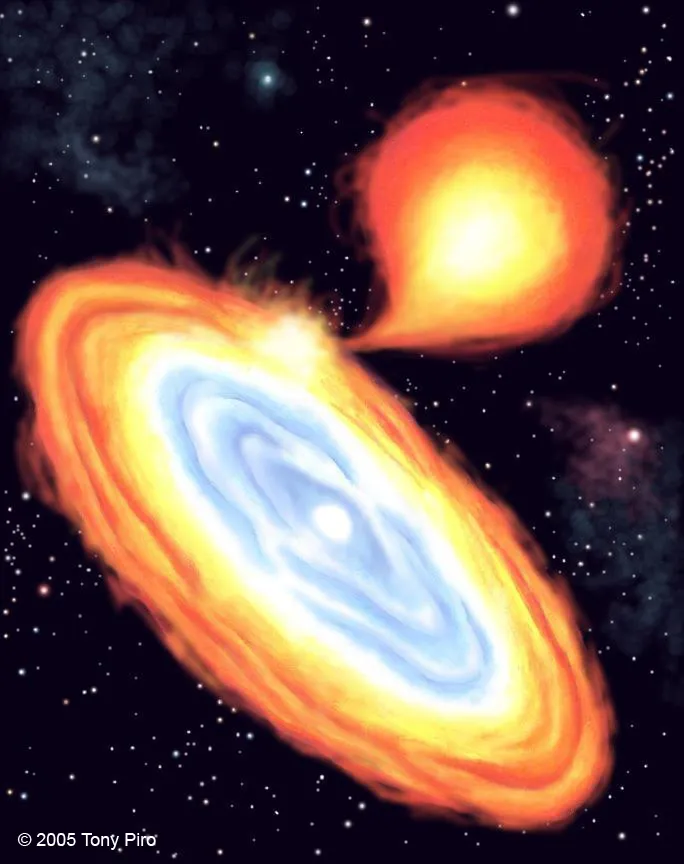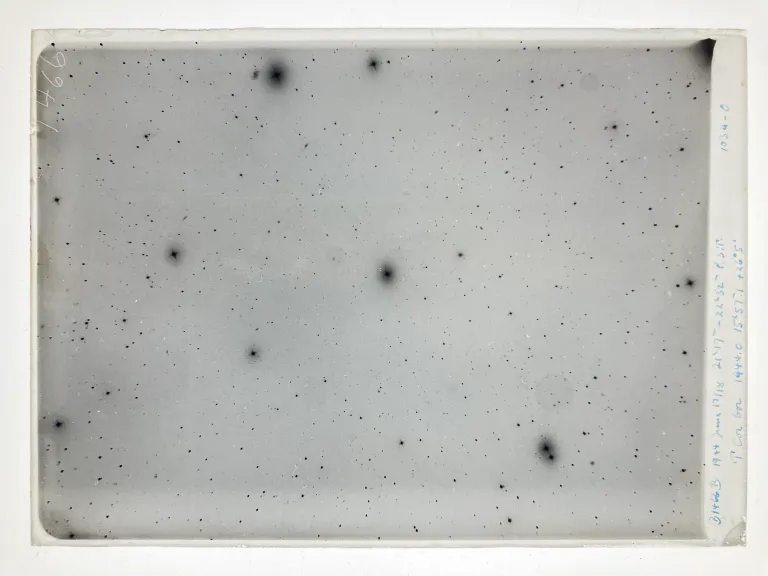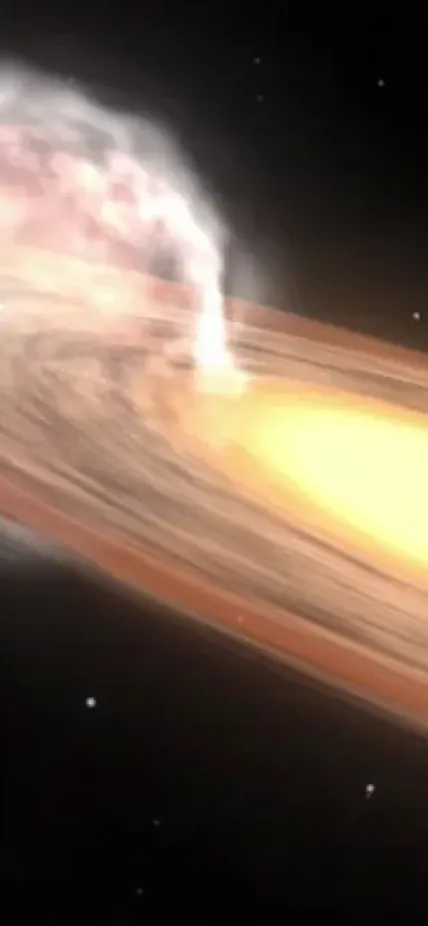
Q: We've seen some headlines about a stellar explosion that might be happening sometime very soon. Can you tell us what this is?
Tony Piro: This is T Coronae Borealis. It is a binary consisting of a white dwarf star and a red giant star. A white dwarf is basically the leftover ember after a star has exhausted its nuclear fuel and has a mass almost 40 percent greater than our Sun.
The binary is in a 227-day orbit. The red giant is so big that its material is being pulled off by the gravity of the white dwarf. This material forms a disk around the white dwarf. Then over time, the disk transfers material onto the white dwarf’s surface.
T Coronae Borealis is known as a “recurrent nova” system. As material builds up on the white dwarf it gets hotter and denser until it ignites a thermonuclear explosion. This burns the surface material, making a bright event that can last for weeks to months. This is called a nova.
Sometimes it takes tens or even hundreds of thousands of years to build up and ignite a nova. Most novae we observe in our galaxy are like this. One of the reasons T Cor Borealis is special is that its novae come much faster. This is because the white dwarf is more massive that most, which causes the accumulating material to reach higher pressures and temperatures much more quickly. There are about 10 of these recurrent novae that we know about in our Galaxy, but T Coronae Borealis is the closest.
Q: When was the last time T Coronae Borealis exploded?
Tony Piro: The last one was 1946 and then before that was 1866. So just from simple math it looks like it should have a nova every 80 years. But on top of that, for each of the previous novae the white dwarf was observed to go through different states as it's ramping up toward the eruption. First, it tends to be bright for about 10 years before the explosion. And we think that's because the disk, as it accumulates more mass it becomes more active in funneling material onto the white dwarf. And in the last 10 years, again, we saw T Coronae Borealis brighten just like the last two times it exploded. Second, for each of the previous novae, the white dwarf began to dim for about a year or so before the explosion. Similarly, as of March 2023, T Coronae Borealis also started getting dim. It is less clear why this happens. One idea is that the disk is sort of emptied out and finished its accretion. And then there's a cooling phase as the material compresses onto the white dwarf, reaching higher pressures and before it's going to explode. So we don't know exactly when it's going to happen, but since it started dimming in March 2023, we’re expecting an explosion basically any time over the next few months.
Q: Why are recurring novae systems like T Coronae Borealis interesting to astronomers?
Tony Piro: It's interesting in a lot of different ways. One is that this is the closest of all the recurrent novae. It’s only about 2,6000 light-years away. So, it’s the one we can study with the most detail. And it recurs relatively frequently, so we can predict it and prepare for the explosion to happen. Because it is so close, we can track how matter accumulates onto the white dwarf over the last 80 years to better understand how the conditions are met for the explosion to trigger.
T Cor Bor is also interesting because its white dwarf is close to the maximum mass that white dwarfs are able to have. White dwarfs are not able to be more massive than the so-called Chandrasekhar limit, which is roughly 1.4 times the mass of our Sun. Above this mass the white dwarf begins to collapse and could potentially explode and produce a Type Ia supernova. When this happens the entire white dwarf is destroyed, not just the surface layers like a nova. Type Ia supernovae are incredibly important, from synthesizing many of the heavy elements that are critical for life to being cosmic beacons that are used to measure the shape and size of the universe. So novae like T Coronae Borealis are interesting for our ongoing efforts to understand how white dwarfs could build up to that limit to produce such a supernova.
On top of that, there has been a resurgence in the study of novae in the last decade or so. That's because with new technologies and new telescopes we've discovered that a lot of high-energy gamma ray emissions are actually coming from the novae. This wasn't at all expected, but photons with gigavolt energies are coming from these events! We think that’s because shocks are being generated from the interaction of the exploding surface layers with the outflow of material from the red giant.
This really wasn’t expected until we had the technology to see it. For example, there these things called Cherenkov detectors that are placed on the ground and enable us to see the cosmic rays—high-energy photons—as they hit Earth’s atmosphere and create showers of particles. And from looking at this, we can reconstruct the energy of those photons and learn about the events that emitted them. We have known for a long time that gamma rays, supermassive black holes at the centers of galaxies, and other cosmic phenomena can produce high-energy emissions, but we only recently learned that these novae can do so as well. So, it’s going to be very exciting to have one of the closest novae to study in this way.

Q: Will non-professional astronomers be able to enjoy this event?
Tony Piro: Yes, definitely! When the explosion triggers, the white dwarf will brighten over about five days, hitting peak magnitude around the same magnitude as the North Star has on the sky. So, it will be as bright as that for a few hours and you’ll be able to see it with your naked eyes. Then the luminosity falls exponentially over the following weeks. So for maybe five days, you will still be able to see it with a good set of binoculars.
This reminds me that another interesting thing is that T Coronae Borealis is the only nova event that actually brightens again after about 100 days. Other recurring novae don’t demonstrate this same feature, so this is something that we want to study more. The second brightening is too dim to be seen with the naked eye. However, with the powerful telescopes that astronomers use for our work, we will be able to study it and learn why it happens. Unfortunately, T Coronae Borealis is only visible in the northern hemisphere and Carnegie Science’s Las Campanas Observatory is in Chile, so we’ll be left out of studying this with our own facilities. A fun fact is that the 1946 eruption was observed at our famous Mt Wilson facility north of Pasadena.
Q: What tools will be available for studying T Cor Bor that weren’t around yet in the 40s or earlier?
Tony Piro: Most of the detections before were, of course, just basically optical light. Nowadays, we can look at objects and phenomena in so many different wavelengths. In addition to optical detectors, the most interesting tools will probably be things like X-ray detectors that can reveal new information about the high-energy emissions. And, as I mentioned before, the Cherenkov detectors that will give us a more picture of the shocks that are driven by the violent explosion on the surface of the white dwarf.

Q: As a theorist, are there theories that we will be able to test by studying T Cor Bor?
Tony Piro: Because T Coronae Borealis is so close and can be observed even when it’s not producing an outburst, we can get an inventory of how much mass was accumulated onto the white dwarf. This can then be compared to how much material is ejected during the explosion, which teaches us about how white dwarfs may gain or lose mass over time. That’s exciting, because when white dwarfs are gaining mass, they might be moving toward becoming Type Ia supernovae.
And then the other thing that I kind of referred to is that there is a lot of interesting physics involved in the particle acceleration of these high-energy emissions. Theorists really get excited about doing the math to explain how that acceleration works, and T Coronae Borealis is an amazing laboratory to test these theories. On top of that, there are these different features, such as the dimming that people speculate is because of the disk clearing out, and things getting a little cooler for a second before the triggering of the eruption. All the features of the dimming, the brightness, and then it has a secondary plateau, are all going to be characterized better to compare with theoretical models.
Q: And is there anything else that we haven't discussed or that you think it's important to understand about this particular phenomenon and others like it?
Tony Piro: It's just fun to think about the fact that because T Coronae Borealis is 2600 light-years away, and it has a nova roughly every 80 years, this means there are over 30 of these eruptions that have already happened, and they're all on our way to us. And so, you can almost, kind of like picture these shells in light of these explosions that have all happened over the past 2600 years, and they’re all traveling toward us through the Milky Way Galaxy right now. So it’s not a matter of when the novae happen but when they finally reach us on Earth so we can learn about them!
Sometimes we talk about things that are fairly abstract in astronomy, but this is something you're going to be able to see with your naked eye and directly point to. It's a unique opportunity to connect with the same sort of excitement astronomers have felt for thousands of years when they discovered something new on the sky. We don’t know exactly when it will happen, but it’s going to be fun when it does.
